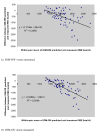Energy prediction equations are inadequate for obese Hispanic youth
- PMID: 21802568
- PMCID: PMC3170752
- DOI: 10.1016/j.jada.2011.05.010
Energy prediction equations are inadequate for obese Hispanic youth
Abstract
Assessing energy requirements is a fundamental activity in clinical dietetics practice. A study was designed to determine whether published linear regression equations were accurate for predicting resting energy expenditure (REE) in fasted Hispanic children with obesity (aged 7 to 15 years). REE was measured using indirect calorimetry; body composition was estimated with whole-body air displacement plethysmography. REE was predicted using four equations: Institute of Medicine for healthy-weight children (IOM-HW), IOM for overweight and obese children (IOM-OS), Harris-Benedict, and Schofield. Accuracy of the prediction was calculated as the absolute value of the difference between the measured and predicted REE divided by the measured REE, expressed as a percentage. Predicted values within 85% to 115% of measured were defined as accurate. Participants (n=58; 53% boys) were mean age 11.8±2.1 years, had 43.5%±5.1% body fat, and had a body mass index of 31.5±5.8 (98.6±1.1 body mass index percentile). Measured REE was 2,339±680 kcal/day; predicted REE was 1,815±401 kcal/day (IOM-HW), 1,794±311 kcal/day (IOM-OS), 1,151±300 kcal/day (Harris-Benedict), and, 1,771±316 kcal/day (Schofield). Measured REE adjusted for body weight averaged 32.0±8.4 kcal/kg/day (95% confidence interval 29.8 to 34.2). Published equations predicted REE within 15% accuracy for only 36% to 40% of 58 participants, except for Harris-Benedict, which did not achieve accuracy for any participant. The most frequently accurate values were obtained using IOM-HW, which predicted REE within 15% accuracy for 55% (17/31) of boys. Published equations did not accurately predict REE for youth in the study sample. Further studies are warranted to formulate accurate energy prediction equations for this population.
Copyright © 2011 American Dietetic Association. Published by Elsevier Inc. All rights reserved.
Figures


Similar articles
-
Accurate determination of energy needs in hospitalized patients.J Am Diet Assoc. 2007 Mar;107(3):393-401. doi: 10.1016/j.jada.2006.12.014. J Am Diet Assoc. 2007. PMID: 17324656
-
Resting energy expenditure in children and adolescents: agreement between calorimetry and prediction equations.Clin Nutr. 2002 Jun;21(3):255-60. doi: 10.1054/clnu.2001.0531. Clin Nutr. 2002. PMID: 12127936
-
Prediction equation of resting energy expenditure in an adult Spanish population of obese adult population.Ann Nutr Metab. 2006;50(3):193-6. doi: 10.1159/000090740. Epub 2006 Jan 10. Ann Nutr Metab. 2006. PMID: 16407645
-
A systematic review and quantitative analysis of resting energy expenditure prediction equations in healthy overweight and obese children and adolescents.J Hum Nutr Diet. 2020 Jun;33(3):373-385. doi: 10.1111/jhn.12735. Epub 2020 Feb 19. J Hum Nutr Diet. 2020. PMID: 32073189
-
Estimates of resting energy expenditure and total energy expenditure using predictive equations in adults with overweight and obesity: a systematic review with meta-analysis.Nutr Rev. 2022 Oct 10;80(11):2113-2135. doi: 10.1093/nutrit/nuac031. Nutr Rev. 2022. PMID: 35551409
Cited by
-
Comparison of predictive equations and measured resting energy expenditure among obese youth attending a pediatric healthy weight clinic: one size does not fit all.Nutr Clin Pract. 2013 Oct;28(5):617-24. doi: 10.1177/0884533613497237. Epub 2013 Aug 6. Nutr Clin Pract. 2013. PMID: 23921297 Free PMC article.
References
-
- Institute of Medicine (U.S.). Panel on Macronutrients. Dietary reference intakes for energy, carbohydrate, fiber, fat, fatty acids, cholesterol, protein, and amino acids. Washington, D.C: National Academies Press; 2005. Standing Committee on the Scientific Evaluation of Dietary Reference Intakes.
-
- Klein CJ, Stanek GS, Wiles CE., 3rd Overfeeding macronutrients to critically ill adults: metabolic complications. J Am Diet Assoc. 1998;98(7):795–806. - PubMed
-
- Harris JA, Benedict FG. A biometric study of basal metabolism in man. Washington: Carnegie institution of Washington; 1919.
-
- Schofield WN. Predicting basal metabolic rate, new standards and review of previous work. Hum Nutr Clin Nutr. 1985;39 (Suppl 1):5–41. - PubMed
-
- Klein CJ. The Harris-Benedict energy studies: additional considerations. J Am Diet Assoc. 1998;98(9):970–971. - PubMed
Publication types
MeSH terms
Grants and funding
LinkOut - more resources
Full Text Sources
Medical

